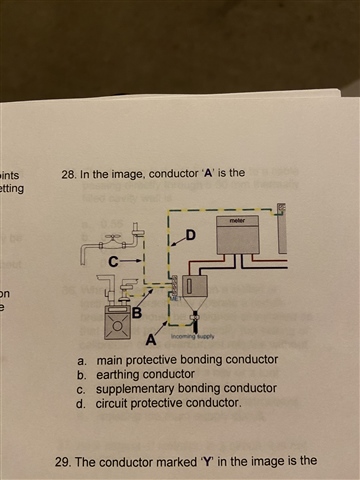 hi started to study for my 18th, wots you guys think the answer is, something tells me it’s different to wots on the answer sheet
hi started to study for my 18th, wots you guys think the answer is, something tells me it’s different to wots on the answer sheet
I think D and A are the same conductor, namely the big CPC for the whole site - I'd not use any term with 'bond'' in the name. The fact it has a MET (Main or Marshalling Earth Terminal )part way along does not alter the primary function of being the thing the ADS in the consumer unit depends on - cut either and you cannot be sure that fuses blow any more.
The plumbing bonds could have joined at the CU end or at the incomer end and not alter that.
Equally I'd not say someone was wrong if they referred to either A or D as the "main earth" - just as long as they did no slip in the word 'bond', . not a question with clear cut 'always right' answer so rather a nasty one.
Mike.
CPC
Well, that would seem logical if you go with the fact that D can't be the earthing conductor ... It is a cpc if you take the view that it connects exposed-conductive-parts of both equipment on final circuits, and the consumer unit (if metal) to the MET.
So, it's a circuit protective conductor without a circuit of its own - or a cpc for all circuits (as this is the link to the MET).
Interesting.
Well, that would seem logical if you go with the fact that D can't be the earthing conductor ... It is a cpc if you take the view that it connects exposed-conductive-parts of both equipment on final circuits, and the consumer unit (if metal) to the MET.
So, it's a circuit protective conductor without a circuit of its own - or a cpc for all circuits (as this is the link to the MET).
This is why I suggested, "main protective conductor".
If it is a CPC, the circuit is the tails. Just because they are not bundled up into one cable does not change that.
However, what if the CU is 16th Edn or earlier and is plastic? There are no exposed CPs to be connected.
Thinking of a simple domestic installation with one DB, the CPCs are clearly part of each final circuit (whether the appliances are Class I or Class II). Looking at the definition of a CPC in Part 2, the final CPCs still have to be connected to the MET. If the MET is the earth terminal bar in the CU, we have no difficulty because D is the earthing conductor.
However, what if the installation serves two DBs, say one for the house and one for the garage? The MET is the terminal block where the earthing splits (just as the live conductors split in the Henley blocks). If you don't like "main protective conductor", how about "main circuit protective conductor"?
If it is a CPC, the circuit is the tails.
The tails themselves may not need a cpc (if they are properly installed they meet the requirements of 412.2.4) ... but a metal CU does.
There are no exposed CPs to be connected.
There are ... downstream of the CU. The definition of cpc doesn't preclude that. In fact, without D being a cpc, the final circuit cpc's wouldn't be in contact with MET and by definition wouldn't be cpc's !
Circuit protective conductor (cpc). A protective conductor connecting exposed-conductive-parts of equipment to the main earthing terminal.
I did say this might be interesting.
If you don't like "main protective conductor", how about "main circuit protective conductor"
Neither are defined in BS 7671, although I guess 'main circuit protective conductor' is a 'circuit protective conductor' for the 'main circuit' - so it's a cpc ?
We're about to take you to the IET registration website. Don't worry though, you'll be sent straight back to the community after completing the registration.
Continue to the IET registration site